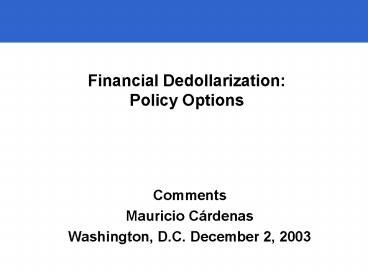Financial Dedollarization: Policy Options - PowerPoint PPT Presentation
1 / 19
Title:
Financial Dedollarization: Policy Options
Description:
This is the common topic in Chang and Velasco (CV), Ize and Powell (IP) ... Attacking the symptoms and not the causes can backfire. 4. de la Torre and Schmukler ... – PowerPoint PPT presentation
Number of Views:39
Avg rating:3.0/5.0
Title: Financial Dedollarization: Policy Options
1
Financial DedollarizationPolicy Options
Comments Mauricio Cárdenas Washington, D.C.
December 2, 2003
2
Three different topics
- What are the effects of financial dollarization
on growth and financial intermediation?
Apparently not very good. - Should financially dollarized economies try
de-dollarize? And if so, how? - This is the common topic in Chang and Velasco
(CV), Ize and Powell (IP), and de la Torre and
Schmukler (DS). All framed in GE settings. - Why financial dollarization is low in some
countries? e.g., Colombia. Lessons for
de-dollarizers.
3
de la Torre and Schmukler
- Explore the joint determinants of duration,
currency, and jurisdiction. - Dollarization as a symptom. Rational responses
(coping mechanisms) to systemic risks (i.e.,
macro price risk, probability and loss of
default, dilution risk, confiscation risk). - Equilibrium settles in favor of contracts that
hedge price risk, even at the cost of exposure to
default risk. Dominance of dollar over
short-duration peso contracts. - Dissuasive prudential regulation may have
unpleasant effects. - Focus on fundamental institutions rather than
exchange rate regime. - Attacking the symptoms and not the causes can
backfire.
4
de la Torre and Schmukler
- Dedollarization exacerbates other risks.
- Need for a 3-pronged approach ER flexibility and
IT, prudential policies, and CPI indexed
contracts. - But not that simple
- Dollarization leads to fear of floating
- Higher capital requirements for dollar loans can
increase short term loans - Real interest rate volatility may hinder
CPI-indexed contracts.
5
Ize and Powell
- Policy endogeneity Fear of floating causes (and
is exacerbated by) dollarization. - Four types (causes?) of dollarization
- Hedge inflation and ER volatility.
- Inefficient peso intermediation.
- Lower default for dollar earning debtors.
- Dollar deposit insurance (moral hazard).
- Optimal prudential responses
- Hedge inflation and ER volatility. Not useful.
- Inefficient peso intermediation. Lower
regulations on peso intermediation and develop
public securities in pesos. - Lower default for dollar earning debtors. Not
clear that the intervention to solve coordination
failures should take this form. - Dollar deposit insurance (moral hazard). Raise
capital requirements for dollar loans or
risk-adjusted deposit insurance premia.
6
Latin America Deposit and Loan dollarization
Sources Central bank statistical publications
and Fund staff estimates.
7
Dollarization trends in Latin America
Deposits
Loans
Public debt
a
a
b
Country
dollarization
dollarization
dollarization
ARGENTINA
14
20
96
BOLIVIA
92
96
95
BRAZIL
0
0
49
CHILE
15
14
45
COLOMBIA
1
5
59
COSTA
RICA
46
55
53
GUATEMALA
10
25
88
HONDURAS
34
26
95
MEXICO
10
32
42
NICARAGUA
71
84
98
PARAGUAY
64
57
NA
PERU
74
79
92
URUGUAY
85
61
96
VENEZUELA
0
1
67
Average LAC
37
40
75
c
Average other emerging
22
19
39
Source Galindo and Leiderman (2003)
8
CPI-Indexation as a Substitute of Dollarization?
Share of Inf-Indexed Deposits
Share of Inf-Indexed Loans
Share of Inf-Indexed Public Internal Debt
Bolivia
0.5
0.1
9.0
8.7 (to Prices)
Brazil
0.0
0.3
84.6 Indexed
Chile
27.3
58.0
73.1
Colombia
0.3
21.2
46.0
Costa Rica
0.0
0.0
20.0
Mexico
0.3
9.3
8.2
Paraguay
0.0
0.0
0.0
Peru
0.0
0.0
0.6
Uruguay
NA
NA
33.9
Venezuela
0.0
0.0
0.0
Source Galindo and Leiderman (2003)
9
Colombia Foreign currency deposits ( of total
deposits).
Source Banco de la República
10
Colombia Foreign currency loans ( of total
loans).
Source Banco de la República
11
Drivers of low dollarization in Colombia
- Real deposit rates (peso) have been positive.
- Foreign currency loans are prohibited.
- Ban on foreign currency deposits.
- No deposit insurance on foreign currency
deposits. - 20 (of capital) limit on banks (long) FX
position. - Large domestic public debt.
- Pension funds limits to foreign currency
denominated securities. - Role of CPI-indexed instruments.
12
What do CPI indexed bonds do?
- Chang and Velascos model captures mutual
relationships between portfolios, shocks and
policies - Under IT, the CPI indexed bonds play no role.
- Fixed ER regime becomes more attractive.
- Ize and Powell CPI indexed bonds are the
appropriate response when dollarization stems
from market imperfections. - de la Torre and Schmukler indexed bonds soften
the trade-off between price risk and default risk.
13
Yearly Growth Rates UPAC and CPI
14
UPAC, UVR and CPI Monthly percent changes
15
Mortgage BanksComposition of Liabilities
16
Inflation-indexed loans ( of total loans)
Source Banco de la República
17
Nearly half of the public debt is domestic
Source Ministry of Finance
18
Domestic debt composition
Source Ministry of Finance
19
Pension Funds Value as Percentage of GDP































